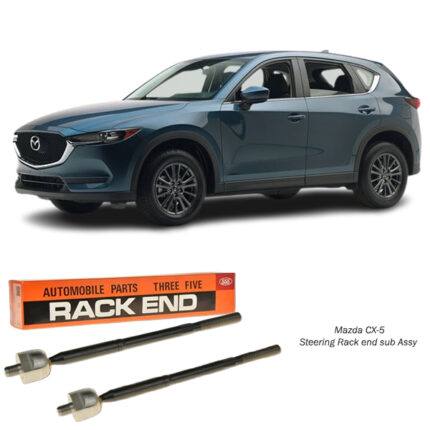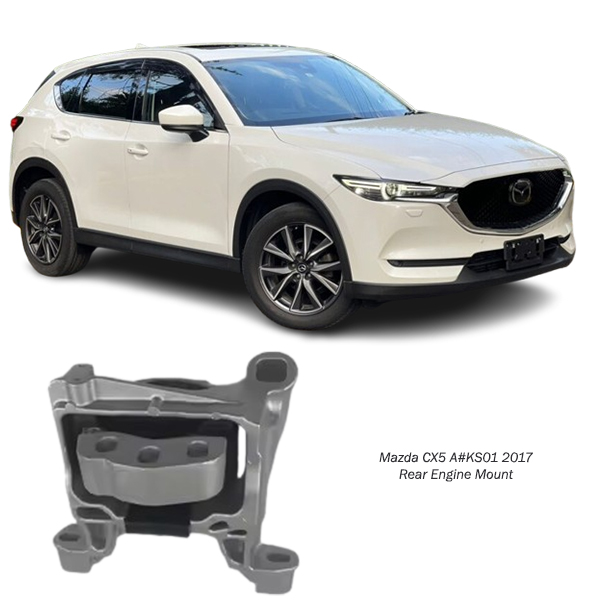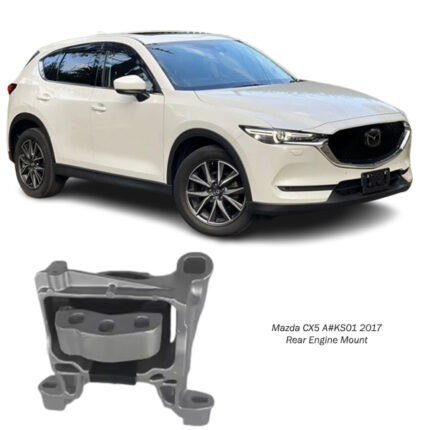Get Mazda CX5 A#KS01 Right Engine Mount KE64-39-060 in Kenya
The right engine mount is a critical component in any vehicle’s engine support system. It serves to secure the engine to the vehicle’s chassis, minimizing vibrations, ensuring alignment, and reducing noise. This guide provides a comprehensive understanding of the right engine mount, its construction, functions, benefits, signs of wear, and maintenance to help ensure optimal performance and vehicle longevity.
Functions of the Right Engine Mount
- Engine Support
The right engine mount secures the engine to the vehicle’s chassis, keeping it in place during operation. - Vibration Damping
It absorbs and isolates vibrations produced by the engine, preventing them from being transmitted to the vehicle’s cabin. - Alignment Maintenance
By keeping the engine in its designated position, the mount ensures proper alignment with other critical components like the transmission and exhaust system. - Noise Reduction
The mount dampens engine noise, ensuring a quieter and more comfortable driving experience. - Dynamic Stability
It helps maintain stability during acceleration, deceleration, and cornering, as the engine’s weight and movement are effectively managed.
Construction of the Right Engine Mount
The right engine mount is engineered to endure the rigors of daily driving, including vibrations, heat, and mechanical stress. Its construction typically includes:
- Metal Frame
The outer frame is usually made from steel or aluminum, providing structural integrity and secure attachment points. - Elastic Core
A rubber or polyurethane core is embedded within the mount to absorb vibrations and cushion the engine. - Hydraulic Mechanism (Optional)
Some modern engine mounts are hydraulic, containing fluid-filled chambers that enhance vibration damping and noise reduction. - Mounting Bolts
These secure the engine mount to both the engine and the chassis, ensuring stability.
Types of Right Engine Mounts
- Conventional Rubber Mounts
Commonly used in passenger vehicles, these mounts provide a balance between cost and functionality. - Hydraulic Engine Mounts
Found in premium or performance vehicles, these mounts contain fluid-filled chambers for superior damping and noise reduction. - Active Engine Mounts
These advanced mounts use sensors and actuators to adjust damping in real-time based on engine activity, offering unparalleled comfort.
Benefits of the Right Engine Mount
- Enhanced Ride Comfort
By isolating vibrations and reducing noise, the mount improves overall driving comfort. - Protection for Components
It prevents undue stress on other engine and chassis components, extending their lifespan. - Improved Vehicle Stability
Properly functioning mounts ensure that the engine remains stable under dynamic conditions, improving handling and safety. - Reduced Maintenance Costs
A quality engine mount minimizes wear on related components, reducing the need for frequent repairs. - Optimized Engine Performance
By maintaining engine alignment, the mount ensures that power delivery to the drivetrain remains efficient.
Signs of a Failing Right Engine Mount
- Excessive Vibrations
Increased vibrations in the cabin, especially during idling or low-speed driving, may indicate a worn or damaged mount. - Unusual Noises
Clunking, banging, or rattling sounds from the engine bay can result from a loose or broken mount. - Misalignment
Misaligned engine components, such as belts or exhaust pipes, often suggest mount wear or failure. - Engine Movement
Visible engine movement during acceleration, braking, or cornering is a clear sign of a failing mount. - Fluid Leaks (Hydraulic Mounts)
Leakage of hydraulic fluid from a mount indicates internal failure, requiring immediate replacement.
Causes of Engine Mount Wear
- Aging and Material Fatigue
Over time, rubber or polyurethane cores degrade due to exposure to heat, oil, and mechanical stress. - Excessive Engine Torque
High-performance driving or carrying heavy loads can put additional strain on the mounts, leading to premature wear. - Exposure to Contaminants
Oil, coolant, or road salt can degrade the mount material, reducing its effectiveness. - Improper Installation
Incorrectly installed mounts may wear unevenly or fail prematurely. - Driving on Rough Roads
Continuous exposure to potholes and rough terrain increases the mechanical stress on engine mounts.
Maintenance of the Right Engine Mount
- Regular Inspections
Check the mount for visible cracks, wear, or deformation during routine vehicle maintenance. - Address Vibrations Early
Investigate and resolve unusual vibrations or noises promptly to avoid further damage. - Replace When Necessary
Replace worn or damaged mounts immediately to maintain vehicle stability and protect other components. - Use Quality Replacements
Opt for OEM (Original Equipment Manufacturer) or high-quality aftermarket mounts for durability and reliability. - Avoid Harsh Driving Conditions
Minimize driving on rough roads or carrying excessive loads to prolong the life of the mount.
Replacement of the Right Engine Mount
Replacing the right engine mount requires technical expertise and the right tools. Here’s an overview of the process:
- Prepare the Vehicle
Park the vehicle on a level surface, engage the parking brake, and disconnect the battery. - Lift the Engine
Use a hydraulic jack and a wooden block to safely lift and support the engine. - Remove the Old Mount
Unscrew the mounting bolts and carefully remove the old mount. - Install the New Mount
Position the new mount, align it correctly, and secure it with the mounting bolts, tightening to manufacturer specifications. - Lower the Engine
Gradually lower the engine back into place, ensuring proper alignment. - Test Drive
After replacement, test the vehicle for vibrations, noises, and stability.
Common Mistakes During Replacement
- Using Inferior Parts
Low-quality mounts may fail prematurely, leading to additional repair costs. - Incorrect Torque
Over- or under-tightening mounting bolts can lead to improper installation or future issues. - Neglecting Alignment
Failing to ensure proper engine alignment can cause stress on related components. - Skipping Inspections
Overlooking other mounts or related parts during replacement may result in unresolved issues.
Importance of Quality Engine Mounts
Investing in a high-quality right engine mount is crucial for vehicle performance and safety. Quality mounts:
- Last longer under stress.
- Provide superior vibration damping.
- Ensure compatibility with the vehicle’s design.
- Reduce long-term maintenance costs.
Conclusion
The right engine mount is a fundamental component that contributes to vehicle stability, comfort, and safety. Understanding its functions, recognizing signs of wear, and maintaining it through regular inspections and timely replacement are essential for optimal vehicle performance. By investing in high-quality parts and professional installation, you can extend the life of your vehicle and enjoy a smooth, vibration-free driving experience.
Follow us on Facebook for more parts.




